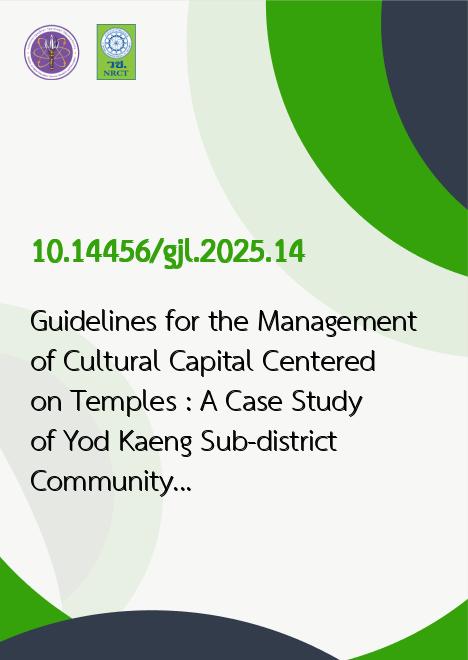
|
Guidelines for the Management of Cultural Capital Centered on Temples : A Case Study of Yod Kaeng Sub-district Community, Namon District, Kalasin Province |
|---|---|
| รหัสดีโอไอ | |
| Creator | Phrakru Wiboonwutthikorn (Sawat Sroiysa-at) |
| Title | Guidelines for the Management of Cultural Capital Centered on Temples : A Case Study of Yod Kaeng Sub-district Community, Namon District, Kalasin Province |
| Contributor | Jariya Intanin, Parisha Marie Cain |
| Publisher | Department of Public Administration, Faculty of Liberal Arts, Kalasin University |
| Publication Year | 2568 |
| Journal Title | Governance Journal, Kalasin University |
| Journal Vol. | 14 |
| Journal No. | 1 |
| Page no. | 293-311 |
| Keyword | Management, Cultural Capital, temple is the center |
| URL Website | https://so01.tci-thaijo.org/index.php/gjournal-ksu |
| Website title | Governance Journal, Kalasin University |
| ISSN | ISSN: 3027-8589 (Online) |
| Abstract | This research study has the objective To study the condition of using cultural capital in community development by using the temple as the center in the Yod Kaeng Subdistrict community area. and to study ways to develop cultural capital to create additional economic value in the Yod Kaeng Subdistrict community area. The researcher used this research method. It is qualitative research using interviews as a tool for collecting data. The target group for the research was 33 random methods, which were divided into 5 groups: monks, administrators of sub-district administrative organizations; Heads of households, community leaders, and community representatives. In Yod Kaeng Subdistrict, Nam District, Kalasin Province. Research findings show that: 1) The implementation of cultural capital for community development in Yot Kaeng Sub-district, Na Mon District, Kalasin Province, centers around temples and encompasses five aspects: community lifestyle, local wisdom, cultural traditions, cultural capital value, and network building. 2) The development of cultural capital for economic value creation integrates three interconnected levels. At the individual level, initiatives promote skilled artisans in creating distinctive value-added products and protecting local wisdom through patent registration. The community system level encompasses two key components: first, enterprise development activities including work presentations, knowledge transfer, and vocational training programs for the general public; second, the development of significant local cultural learning initiatives that support the enhancement and continuation of local traditions. The provincial/network level emphasizes youth engagement in cultural preservation activities. This multi-level framework facilitates comprehensive cultural capital development while promoting economic growth through community participation. |
